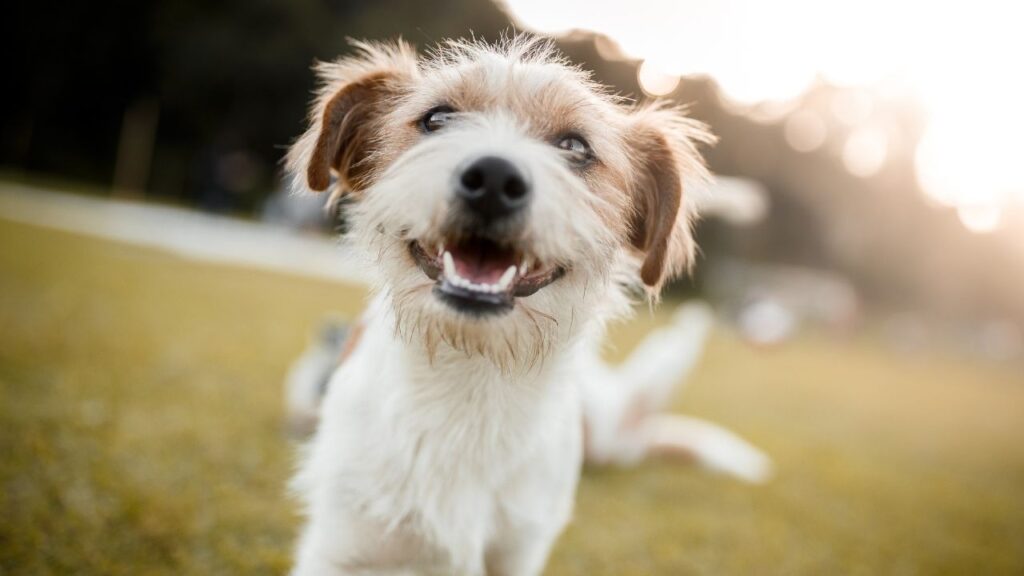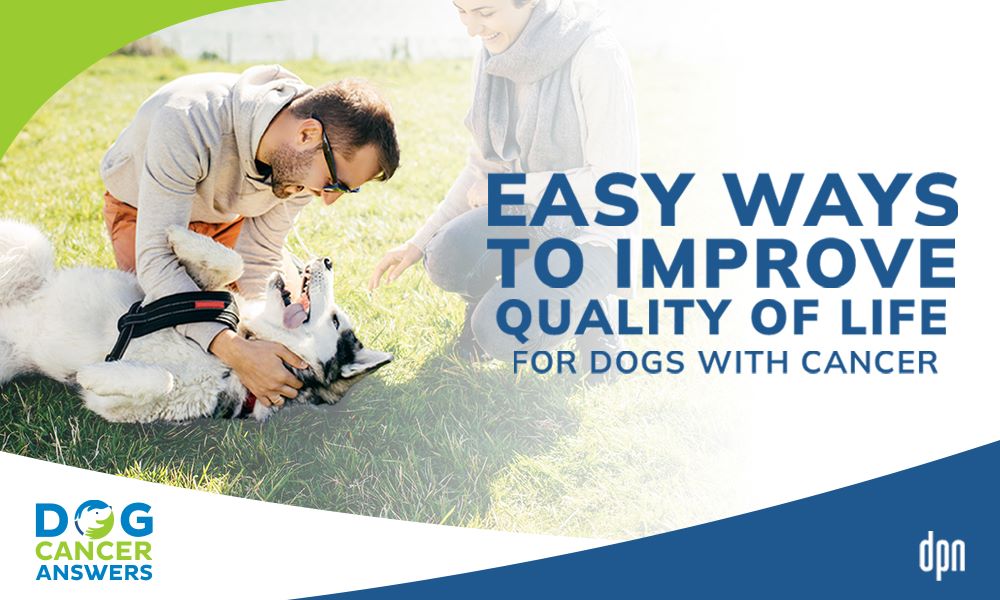Exercise has many benefits and is an excellent way to help your dog build and maintain muscle mass, strengthen their cardiovascular system, preserve their cognitive health and even reduce the severity and progression of cancer. There are many different forms of exercise that you can participate in with your dog that can be tailored to fit their breed, size, age and health status. Get ready, set, PLAY!
Key Takeaways
- If dogs do not get enough exercise, they can become overweight, develop chronic illnesses, lose mobility and become stressed.
- The best exercise for your dog depends on their energy level, age and health status.
- You should try and provide your dog with at least 30 minutes to 2 hours of exercise daily.
- Daily physical activity is important for all dogs to maintain muscle tone, expend calories to maintain a healthy weight and stimulate their senses. More intense activity or exercise is appropriate for most healthy dogs and can provide many health benefits.
Exercise for Dogs Is Healthy and Fun
Daily movement is important for your dog to help keep their body functioning and active. Additionally, encouraging regular, structured activity, or exercise, can provide health benefits that normal activity may not be able to achieve.1
Exercise is a stress to the system that forces the body to adapt in ways that can provide significant health benefits. When exercise is performed regularly, it can result in physical fitness – the ability of an individual to perform work requiring muscle strength, cardiovascular function, flexibility, and endurance.2
How Much Exercise Does a Dog Need?
To achieve benefits from exercise, the body needs to reach an activity level that goes beyond everyday movement. This is called the overload principle and it means that the current physical abilities need to be reached and exceeded to reach fitness.
Different factors that may affect overload of a body include intensity, frequency, and duration of a particular exercise.3
Exercise Builds Strength in Dogs
The primary body system affected by exercise is the musculoskeletal system, ie the muscles, tendons, ligaments and bones that allow the body to move and exert force.
Strength and high-resistance training result in an increased diameter of muscle fibers. As the muscle fibers get larger, they are able to perform tasks more effectively.
Strength
Strength in dogs usually refers to speed and their ability to carry or pull heavy loads. Examples of strengthening exercises include running, pulling resistance loads, running up inclines or swimming against jets.
Endurance
Endurance is closely tied with strength and refers to the body’s ability to continue a particular activity for a prolonged period of time, usually for more than 15 minutes. Endurance exercises can include running, swimming, land or water treadmill usage and sled pulling.
Both Strength and Endurance
Many forms of canine exercise and sporting activities require a high level of both strength and endurance such as dog racing, herding, sled racing and flyball or disc.2
Your Dog’s Cardiovascular System Gets Benefits, Too
The cardiovascular system consists of the heart and lungs and provides an effective delivery of oxygen and nutrients to the body, especially the muscles, during periods of exercise.
During physical exertion, there is an increase in heart rate and strength of cardiac contraction as well as an increase in the breathing, or ventilation rate.
These changes work together to match the increased need for oxygen and nutrients in the muscles and get rid of wastes. Blood is redistributed from inactive areas of the body to the skeletal muscles during intense physical activity for the most efficient energy and gas delivery possible.
Temperature Regulation
The cardiovascular system also plays a major role in thermoregulation, or the body’s ability to control its internal temperature.
The increased work required for exercise causes heat and results in a rising body temperature. This rise in temperature can cause organ damage or death if it is not controlled. The dog’s body adapts to increasing temperatures by panting which causes evaporation of water from the surfaces of the mouth.
The elevated heart rate and increased blood flow to the respiratory tract and surfaces of the mouth allow for effective heat loss. Dogs do not have well developed sweat glands like people do, so panting is their most effective way at reducing their internal temperature to a safe level.
Most dogs can effectively manage their internal temperatures in temperatures from 70-85°F, although there is variation among dogs of difference sizes and coat lengths and breeds.4
Exercise Is Important for Many Reasons
Daily physical activity or exercise are important for dogs to help them maintain a healthy weight, maintain strength and muscle mass, reduce stress and provide important mental stimulation.
Obesity has been shown to affect a dog’s quality of life, and losing weight can improve life quality. Exercise can help maintain your dog at a healthy weight and prevent increases in pain and chronic illnesses associated with weight gain.4 Regular physical activity and exercise help your dog maintain strength and lean muscle mass which preserve their mobility.5
When dogs are not allowed to exercise daily, they can experience chronic stress which can result in behaviors like overgrooming, crying and stool eating.6
Exposure to the outdoors also provides dogs with an opportunity for mental stimulation where they can see, hear, smell and touch new and different things. You should vary the type of exercise you do with your dog so they can receive that stimulation. This can include where you take them for their walks or what kind of activities you do with them.7
Other Reasons to Make Sure Your Dog Gets Exercise
Regular exercise can provide your dog with many health benefits that can help keep him healthy and even reduce the severity of medical conditions.
Osteoarthritis
Regular exercise, especially swimming in a controlled environment, can increase muscle mass, strength and endurance and reduce pain in dogs with osteoarthritis.
Aquatic exercise is particularly effective for dogs with osteoarthritis because the properties of water, like buoyancy, resistance and hydrostatic pressure, help stimulate muscle activity while taking pressure off of painful joints.
This doesn’t mean you should head out to the nearest lake with your dog with osteoarthritis. Dogs with neck problems, cardiac issues, and other physical problems may be deconditioned and need to be carefully supervised when swimming. A good rehabilitation (physical therapy) veterinarian will be a great resource to get your dog in shape safely.
Because aquatic treadmills like those found in veterinary settings can really help dogs with osteoarthritis.
- In one study, exercise on an aquatic treadmill 2-3 times per week for 8 weeks improved the range of motion of the knee and hip joints by 5%, in both healthy dogs and dogs with arthritis.13
- An increased range of motion in painful joints improves the absorption of synovial fluid by the cartilage in joints which provides anti-inflammatory and cartilage protecting properties.5,13,14
Digestive Tract
Regular exercise can benefit dogs experiencing both constipation and inflammatory bowel disease (IBD).
In one study, exercise was able to stimulate the large bowel in dogs 3-6 hours after exercise and can be beneficial to older and inactive individuals who may be experiencing constipation.15
Exercise can also benefit dogs with inflammatory bowel disease. One study showed that after 10 weeks of exercise, disease symptoms in dogs with inflammatory bowel disease were significantly improved and resulted in no negative side effects.16
This beneficial impact of exercise is likely due to its anti-inflammatory properties that result in positive effects throughout in the body.17
Weight-loss
Obesity has become an increasing health concern in dogs. Excess weight in dogs can cause multiple health problems like an increased risk of degenerative joint disease, cancer, reduced quality of life and a reduced lifespan.
Keeping your dog at a healthy weight can reduce the risk of these health issues and exercise is a great way to help your dog lose that extra weight.
The odds of a dog becoming obese decrease with each hour of weekly physical activity they receive. While reducing your dog’s caloric intake is an important component of weight loss, regular exercise can assist the process by helping your dog maintain lean muscle mass.
Lean muscle mass is metabolically active and can delay the development of sarcopenia, or muscle loss, that can happen as dogs get older. That means that instituting an exercise regimen can help keep your dog stay active for longer in his senior years.5,18
Cognitive Health
Exercise can also play an important role in improving your dog’s cognitive function.
Some senior dogs develop cognitive dysfunction much like Alzheimer’s disease in people. Studies show that exercise in dogs aged 6-18 years resulted in significant improvements in the severity of cognitive symptoms like memory and prevented the worsening of symptoms over a 6-month period.
Also, the preservation of cognitive function was enhanced when dogs were placed on an antioxidant diet along with their exercise regimen.19
Cancer Benefits of Exercise for Dogs
Regular physical activity and exercise provides multiple benefits for dogs with cancer including a reduced severity and slowed progression of cancer, improved effectiveness of cancer treatments and a better quality of life.
Exercise can affect the metabolism of cancer cells causing anti-tumor properties which delay disease progression and metastasis, or spreading of the cancer, and reduce cancer-related death. These positive effects were confirmed in both human and animal studies.20
The movement and increased blood flow in exercise cause strengthening and remodeling of blood vessels in the body. This remodeling can impact the small blood vessels often present in tumors, resulting in increased blood flow to the cancer itself.
The increased blood flow results in an enhanced ability of white blood to reach, detect and kill cancer cells.21 In fact, a 45-60 minute bout of vigorous exercise in people was shown to increase the concentration of some immune cells 10-fold.
An increased blood flow in tumors allows cancer treatments like chemotherapy to reach more of the cancer and can make the medication more effective at killing the abnormal cells.22,23
You Benefit, Too, From Exercise for Dogs
Physical activity with your dog can provide multiple physical and psychological benefits. Walking your dog can help you meet recommended levels of activity more easily which can reduce the risk and severity of obesity and chronic health conditions.
Walking dogs encourages faster walking speeds and can increase the amount of weekly moderate physical activity you receive. These benefits can benefit people of all ages but may especially help older adults maintain mobility and fitness later in life.
Walking with your dog can also provide a feeling of safety and purpose as well as provide opportunities for social interactions along the walk.24
People who participate in sporting events with their dogs report multiple benefits from the activities. Some of those benefits include opportunities to learn and work with their dogs as a team, a strengthening of the bond and connection with their dog and the rewards and accomplishment of competing in dog sports.25
When Your Dog Should Avoid Exercise
Even though engaging your dog in an exercise regimen has many potential benefits, it can be dangerous or even life-threatening in some situations.
Temperature
Dogs can produce an incredible amount of heat during strenuous exercise. Healthy Labrador retrievers can develop internal temperatures of up to 107.5°F when exercising in temperatures up to 82°F.
Most dogs can effectively manage their internal temperatures in environments from 70-85°F, but you should always be careful when exercising your dog in warm weather and high humidity. Heat stroke can occur fairly easily when external temperatures exceed the tolerable range.
Dehydration can also result in heat stroke because it reduces a dog’s ability to effectively evaporate heat. Therefore, it is important to make sure your dog is well hydrated when exercising and prevented from excessive activity while dehydrated.8
Breed conformation
Some dogs, especially in the brachycephalic breeds, are less able to adapt to the heart and lung demands of exercise due to their head and throat shape.
Brachycephalic dogs have a shortened head and muzzle which causes extra tissue in the throat that can cause loud breathing noises as well as heat and exercise intolerance.
These symptoms are part of a condition called BOAS or brachycephalic obstructive airway syndrome and can also cause gastrointestinal problems, respiratory distress and choking fits in some cases.26
Some common brachycephalic breeds that are often affected include pugs, French bulldogs, English bulldogs and the Pekingese.27
In one study, brachycephalic obstructive airway syndrome became pronounced in pugs trotting for just over 5 minutes and caused a significant increase in body temperature compared to non-brachycephalic dogs.
Since panting is the most effective way for a dog to cool down, difficulty breathing can result in both respiratory distress and overheating.26
In another study where dogs were asked to walk for 6 minutes, English bulldogs performed significantly worse than dogs of other breeds in speed, distance and recovery time after exercise as well as having an increased body temperature.28
If you have a brachycephalic dog, it is important to monitor your pet closely while engaging in physical activity. You should keep their level of exercise intensity low and stop immediately if you notice abnormal breathing sounds or they appear to be having difficulty breathing.
You should also keep physical activity to an absolute minimum in warm weather when your dog may not be able to effectively cool themselves down.
If you notice that your brachycephalic dog is being limited by their respiratory symptoms, there are some surgical procedures available that can help. These procedures can include removing part of the nose blocking their nostrils or the tissue in the back of the throat so that they can breathe more effectively and comfortably.29
Injury
Exercise can sometimes result in injury or worsening of pre-existing conditions. Some conditions that may be affected can include fractures, intervertebral disc disease, heartworm disease or recovery from a surgical procedure and others.
If your dog has a chronic injury or is healing from an acute issue, it may be important to limit their physical activity. The added force and stress placed on the body during exercise can delay healing or worsen their condition.
If your veterinarian has recommended restricted exercise for your dog, you should limit their physical activity as much as possible outside of quick bathroom breaks. You should make a follow-up appointment with your vet to get them cleared for exercise before allowing more extended physical activity.30
Age
Dogs of all shapes, sizes and ages can benefit from regular physical activity, but care should be taken with very young or senior dogs.
Young puppies under 5 months of age have softer bones with open growth plates, meaning that they are more prone to injury from excessive exercise.
It is important to provide your young dog with opportunities for self-directed play on soft surfaces like grass and avoid strenuous or repetitive exercise like hiking and running. You should also prevent them from jumping down from surfaces greater than elbow-height.
Senior dogs can get many benefits from exercise well into their later years, but that activity should be at a slower, gentler pace.
Strenuous activity should be avoided in older pets because they are more likely to have conditions like osteoarthritis and heart disease and develop injuries.
Older dogs can benefit from regular low-intensity exercise instead. Getting your older dog in shape with a rehabilitation veterinarian, perhaps using an aquatic treadmill, is a great way to help take pressure off of their joints and allows them to build and maintain muscle tone while having fun.30
Compromised Heart and Lung Health
Dogs with heart or lung diseases should be kept at a low level of physical activity without prior approval from your veterinarian for more intense exercise.
Even though scientific studies have shown a positive impact of exercise on dogs with heart disease or failure, those results were obtained through controlled laboratory experiments.
Therefore, you should use extreme care during physical activity with your dog with heart disease as excessive stress can cause acute heart failure or even sudden death.31
Dogs with diseases affecting their lungs should also receive a minimal amount of exercise unless otherwise approved by their veterinarian.
Reduced lung function will impair a dog’s ability to get oxygen to working muscles as well as result in overheating. Conditions that impair lung function would include diseases such as pneumonia and asthma.32
If your dog has reduced heart or lung function, it is important to look out for sudden changes in their willingness to walk as well as any coughing, wheezing, or fainting that occurs while active.
These symptoms could indicate a worsening of their condition and they should be examined by their veterinarian to see if any additional medical interventions are needed.
Heritable Exercise Intolerance
For some dogs, exercise can cause neurological collapse and even death in severe cases. Genetic conditions of exercise-induced collapse (EIC) exist in some border collies, Labrador retrievers and related breeds.
Border collie collapse (BCC) can occur in border collies and in several related breeds such as Australian shepherds, bearded collies, kelpies, whippets and Shetland sheepdogs.
Symptoms typically start around 2 years of age and can include disorientation, swaying, staggering and falling or dragging the legs after 5-15 minutes of strenuous activity.
As long as exercise is stopped immediately, symptoms typically resolve in about 30 minutes.33 Since this is an inherited genetic condition, there is no cure, so it is recommended to avoid all forms of strenuous activity with these dogs, especially in hot weather.34
A similar form of exercise-induced collapse (EIC) is also found in Labrador retrievers and related breeds such as the curly coated retrievers, Chesapeake Bay retrievers, cocker spaniels, German wirehaired pointers, Boykin spaniels, Pembroke Welsh corgis, Bouvier des Flanders and Old English sheepdogs.
The Labrador form of exercise-induced collapse is about as prevalent as Border collie collapse and has similar symptoms such as wobbling and collapse that start in the hind limbs in otherwise healthy dogs after strenuous or overly exciting activities.
Symptoms typically resolve after resting for 25 minutes and the best prevention strategy is to avoid highly active or arousing activities.
If you have one of the above breeds and you witness an episode of disorientation or collapse, you should have your dog examined by their veterinarian. A genetic test is available to confirm the diagnosis. Because these conditions are heritable, you should not breed your dog to avoid passing it on to puppies.35
What Kinds of Exercise to Try with Your Dog
A common question when discussing exercise in dogs is, “How much exercise does my dog need?”
Since dogs come in all shapes, sizes, energy and health levels, the ideal amount of daily exercise can vary between dogs.
These are some general recommendations that can help get you and your dog started.
- Some form of daily physical activity is important for all dogs, not just in terms of their physical health, but for their mental wellbeing as well.
- A good place to start is to try and provide your dog with at least 30 minutes to 2 hours of exercise daily. It is important to remember that this is a general recommendation.
Lower energy or brachycephalic dogs might only tolerate low intensity exercise for a small amount of time each day while higher energy dogs may require more than 2 hours to get them tired out and prevent them from getting destructive or anxious at home.36
- If your dog will be participating in exercise more intense than walking, you should avoid large meals prior to physical activity. A light meal and access to water before exercise is recommended.30
- It is tempting to ramp up the amount and intensity of exercise on the weekends when you have more time to devote to your pet, but this can result in injury if your dog only receives a small amount of daily exercise during the week.
If you are interested in having your dog participate in competitive sporting events, you can consult a professional to help you design a training program for you and your dog that will fit into your schedule.
These are examples of high energy breeds that may need more exercise:37
- Belgian Malinois, Border Collies, Doberman Pinschers, Vizsla, American Staffordshire Terriers
These are examples of low energy breeds that may require less exercise:38
- Bulldogs, Bassett Hounds, Pugs, Pekingese
Low-intensity Exercise
Walking – walking allows your dog to go at his own pace and is the most basic form of exercise you can do with your dog.
Leisure Swimming – swimming is considered low-impact exercise, although it might feel very intense for an out of shape dog. If your dog is in good physical condition, swimming might feel like a low-intensity exercise. If your dog is out of condition, a walk might be a safer choice until they can build up some endurance.
Medium-intensity Exercise
Hiking – hiking is an excellent strength exercise for the whole body. Hiking on a flat trail is considered moderate intensity but can be made more intense with hilly or uneven terrain.
Jogging – if your dog seems to need more intense exercise than your regular walks, you can try bringing him up to a trot to work out some extra energy.
Leisure fetch on land or water – Having your dog find and bring toys back to you can vary in intensity from a leisure activity to high energy exercise depending on how far they need to move to get the toy.
High-intensity Exercise
Running – Running is a good way to increase the intensity from jogging and you can have your dog build additional strength in his hind limbs by running up hills. Be careful to have your dog come back down slowly as it can stress the forelimbs too much when running down steep hills.39
Pulling weights – Pulling weights is another great way to help your dog build strength in the hindlimbs. You can have your dog pull weights on a sled or on a wheeled cart.
Endurance – Endurance activities involve having your dog participate in aerobic exercise at a trot for at least 20 minutes or swim for at least 5 minutes. You should make sure your dog is comfortable with low and medium intensity exercise before attempting endurance activities.
Treadmills can be used to help your dog build endurance, but should be at least 2.5 times the length of their body in order to avoid injury.39
Performance Sports
Sporting events can be categorized by how much they involve strength or endurance abilities.
Having your dog participate in competitions or performance sports is a great way to see what they can achieve athletically.
These sporting activities are designed to be fun for both you and your dog but may require some training and conditioning to help prepare them for competition.
The following are examples of some competitive or performance based sports that your dog can participate in:30
Agility, Barn hunt.45 Carting, Disc dog, Dock diving, Earth dog,46, Field trials, Flyball, Hare coursing, Herding,47 Lure coursing,48 Mushing, Obedience, Retrieving trials, Schutzhund, Tracking,49 Trail running
For detailed information about these different sports, please visit the websites below:50,51
https://www.caninebible.com/dog-sports/
How to get started:52
https://www.akc.org/expert-advice/sports/get-started-in-dog-sports-and-events/
National American Sport Dog Association – Provides information about upcoming events and how to register your dog:53
American Kennel Club – Provides information on sporting clubs and events in your state:51
https://www.apps.akc.org/club-search/#/
The Importance of Warming Up
Warming up before exercise improves flexibility, proprioception (limb awareness) and performance and helps reduce the likelihood and severity of injuries.
Warm-up exercises will be most helpful if they mimic the types of movements needed for the type of sport.
For sports that require a lot of energetic movements or jumping, effective warm-ups can include 2-3 minutes of walking and then trotting as well as tugging and dynamic stretching like bows, waves, begging and spinning.
You can tell when your dog has been sufficiently warmed up when they are lightly panting.
Don’t Forget to Cool Down Your Dog
After strenuous activity, a cool down can help get your dog back to their resting state and allow you to monitor for any possible injuries.
An effective cool-down consists of gradually reduced movement intensity like trotting to walking and then a full-body rub down.
The Importance of Rest
If your dog is participating in high intensity or strenuous activities, it is important to allow him 2-3 days of rest so the muscles have time to heal. Overworking your dog can reduce the effectiveness of your exercise regimen and result in injuries.39
Where to go for more guidance:
If you have questions about how best to help your dog train for a sporting event or ways to reduce the chance of injury, you should make an appointment with a canine sport trainer or sport medicine and rehabilitation professional in your area:
Association of Professional Dog Trainers:54
American Association of Rehabilitation Veterinarians:55
https://www.rehabvets.org/directory.lasso
Additional suggestions of exercises for you and your dog:40,41
https://www.hillspet.com/dog-care/play-exercise/exercise-and-game-ideas-for-dogs
https://www.akc.org/expert-advice/health/how-much-exercise-does-dog-need/
How to design a walking program for you and your dog:42
https://www.avma.org/resources-tools/pet-owners/petcare/walking-your-pet
Guidance for pets who may need to lose a few pounds:43
https://www.aaha.org/aaha-guidelines/weight-management-configuration/exerciseactivity/
Article about the importance of physical therapy for dogs with osteoarthritis:44
https://caninearthritis.org/article/why-every-dog-with-arthritis-should-have-a-physical-therapist/
- Ané. Exercise Physiology: Go Beyond to Prepare Your Patients for Life | Onlinepethealth. Published June 3, 2021. Accessed January 11, 2023. https://onlinepethealth.com/exercise-physiology-go-beyond-to-prepare-your-patients-for-life/
- Marcellin-Little DJ, Levine D, Taylor R. Rehabilitation and Conditioning of Sporting Dogs. Vet Clin North Am Small Anim Pract. 2005;35(6):1427-1439. doi:10.1016/j.cvsm.2005.08.002
- Lee HS, Kim JH. The dog as an exercise science animal model: a review of physiological and hematological effects of exercise conditions. Phys Act Nutr. 2020;24(4):1-6. doi:10.20463/pan.2020.0021
- German AJ, Holden SL, Wiseman-Orr ML, et al. Quality of life is reduced in obese dogs but improves after successful weight loss. Vet J. 2012;192(3):428-434. doi:10.1016/j.tvjl.2011.09.015
- Frye CW, Shmalberg JW, Wakshlag JJ. Obesity, Exercise and Orthopedic Disease. Vet Clin North Am Small Anim Pract. 2016;46(5):831-841. doi:10.1016/j.cvsm.2016.04.006
- Beerda B, Schilder MBH, Van Hooff JARAM, De Vries HW, Mol JA. Chronic Stress in Dogs Subjected to Social and Spatial Restriction. I. Behavioral Responses. Physiol Behav. 1999;66(2):233-242. doi:10.1016/S0031-9384(98)00289-3
- Heath S, Wilson C. Canine and Feline Enrichment in the Home and Kennel. Vet Clin North Am Small Anim Pract. 2014;44(3):427-449. doi:10.1016/j.cvsm.2014.01.003
- Millard R. Exercise Physiology of the Canine Athlete. In: Canine Rehabilitation and Physical Therapy. Elsevier; 2014:162-179. doi:10.1016/B978-1-4377-0309-2.00009-0
- Feng R, Wang L, Li Z, et al. A systematic comparison of exercise training protocols on animal models of cardiovascular capacity. Life Sci. 2019;217:128-140. doi:10.1016/j.lfs.2018.12.001
- Domenech R. Exercise induces early and late myocardial preconditioning in dogs. Cardiovasc Res. 2002;55(3):561-566. doi:10.1016/S0008-6363(02)00334-6
- Todaka K, Wang J, Yi GH, et al. Impact of exercise training on ventricular properties in a canine model of congestive heart failure. Am J Physiol-Heart Circ Physiol. 1997;272(3):H1382-H1390. doi:10.1152/ajpheart.1997.272.3.H1382
- Wang J, Yi GH, Knecht M, et al. Physical Training Alters the Pathogenesis of Pacing-Induced Heart Failure Through Endothelium-Mediated Mechanisms in Awake Dogs. Circulation. 1997;96(8):2683-2692. doi:10.1161/01.CIR.96.8.2683
- Nganvongpanit K, Tanvisut S, Yano T, Kongtawelert P. Effect of Swimming on Clinical Functional Parameters and Serum Biomarkers in Healthy and Osteoarthritic Dogs. ISRN Vet Sci. 2014;2014:1-8. doi:10.1155/2014/459809
- Gross Saunders D. Therapeutic Exercise. Clin Tech Small Anim Pract. 2007;22(4):155-159. doi:10.1053/j.ctsap.2007.09.003
- Dapoigny M, Sarna SK. Effects of physical exercise on colonic motor activity. Am J Physiol-Gastrointest Liver Physiol. 1991;260(4):G646-G652. doi:10.1152/ajpgi.1991.260.4.G646
- Dunning M. Improving IBD in dogs through exercise. Vet Rec. 2017;180(9):222-223. doi:10.1136/vr.j1034
- Pedersen BK. Anti-inflammatory effects of exercise: role in diabetes and cardiovascular disease. Eur J Clin Invest. 2017;47(8):600-611. doi:10.1111/eci.12781
- Vitger AD, Stallknecht BM, Nielsen DH, Bjornvad CR. Integration of a physical training program in a weight loss plan for overweight pet dogs. J Am Vet Med Assoc. 2016;248(2):174-182. doi:10.2460/javma.248.2.174
- Cotman CW, Berchtold NC. Physical activity and the maintenance of cognition: Learning from animal models. Alzheimers Dement. 2007;3(2S). doi:10.1016/j.jalz.2007.01.013
- Vulczak A, Alberici LC. Physical Exercise and Tumor Energy Metabolism. Cancer Treat Res Commun. 2022;32:100600. doi:10.1016/j.ctarc.2022.100600
- Idorn M, Hojman P. Exercise-Dependent Regulation of NK Cells in Cancer Protection. Trends Mol Med. 2016;22(7):565-577. doi:10.1016/j.molmed.2016.05.007
- Ashcraft KA, Warner AB, Jones LW, Dewhirst MW. Exercise as Adjunct Therapy in Cancer. Semin Radiat Oncol. 2019;29(1):16-24. doi:10.1016/j.semradonc.2018.10.001
- Hojman P, Gehl J, Christensen JF, Pedersen BK. Molecular Mechanisms Linking Exercise to Cancer Prevention and Treatment. Cell Metab. 2018;27(1):10-21. doi:10.1016/j.cmet.2017.09.015
- Epping JN. Dog Ownership and Dog Walking to Promote Physical Activity and Health in Patients: Curr Sports Med Rep. 2011;10(4):224-227. doi:10.1249/JSR.0b013e318223ee41
- Farrell J (Joey) M, Hope AE, Hulstein R, Spaulding SJ. Dog-Sport Competitors: What Motivates People to Participate with Their Dogs in Sporting Events? Anthrozoös. 2015;28(1):61-71. doi:10.2752/089279315X1412935072201
- Mach R, Wiegel PS, Bach JP, Beyerbach M, Kreienbrock L, Nolte I. Evaluation of a Treadmill-Based Submaximal Fitness Test in Pugs, and Collecting Breed-Specific Information on Brachycephalic Obstructive Airway Syndrome. Animals. 2022;12(12):1585. doi:10.3390/ani12121585
- Department of Veterinary Medicine, Cambridge Veterinary School. About BOAS. Published February 16, 2016. Accessed April 10, 2023. https://www.vet.cam.ac.uk/boas/about-boas
- Lilja-Maula L, Lappalainen AK, Hyytiäinen HK, et al. Comparison of submaximal exercise test results and severity of brachycephalic obstructive airway syndrome in English bulldogs. Vet J. 2017;219:22-26. doi:10.1016/j.tvjl.2016.11.019
- Dupré G, Heidenreich D. Brachycephalic Syndrome. Vet Clin North Am Small Anim Pract. 2016;46(4):691-707. doi:10.1016/j.cvsm.2016.02.002
- Nalepa L. Preventing injuries in canine athletes. IVC Journal. Published May 23, 2018. Accessed January 13, 2023. https://ivcjournal.com/preventing-injuries-canine-athletes/
- DVM EB. Heart Failure in Dogs: 6 Practical Tips From Veterinary Cardiologists. Today’s Veterinary Practice. Published July 16, 2015. Accessed January 13, 2023. https://todaysveterinarypractice.com/cardiology/heart-failure-in-dogs-6-practical-tips-from-cardiologists/
- Introduction to Lung and Airway Disorders of Dogs – Dog Owners. Merck Veterinary Manual. Accessed January 13, 2023. https://www.merckvetmanual.com/dog-owners/lung-and-airway-disorders-of-dogs/introduction-to-lung-and-airway-disorders-of-dogs
- Norton EM, Minor KM, Taylor SM, McCue ME, Mickelson JR. Heritability and Genomic Architecture of Episodic Exercise-Induced Collapse in Border Collies. Genes. 2021;12(12):1927. doi:10.3390/genes12121927
- Getting to the bottom of border collie collapse. Accessed January 14, 2023. https://www.aaha.org/publications/newstat/articles/2016-12/getting-to-the-bottom-of-border-collie-collapse/
- Exercise-induced collapse (EIC) – Veterinary Medical Centre – Western College of Veterinary Medicine | University of Saskatchewan. Accessed January 14, 2023. https://vmc.usask.ca/services/medicine-eic.php#AboutEIC
- Exercising With Your Dog 101. Accessed January 15, 2023. https://www.petmd.com/dog/wellness/evr_dg_exercising_with_your_dog101
- Nov 21 AS, Minutes 2022 | 3. 10 Active Dog Breeds That Will Help You Stay Fit. American Kennel Club. Accessed January 15, 2023. https://www.akc.org/expert-advice/lifestyle/active-dog-breeds-that-will-help-you-stay-fit/
- Low-Energy Dog Breeds | Purina. Accessed January 15, 2023. https://www.purina.com/dogs/dog-breeds/collections/low-energy-dog-breeds?page=0
- Zink C, Carr BJ. Conditioning and Retraining the Canine Athlete. In: Zink C, Van Dyke JB, eds. Canine Sports Medicine and Rehabilitation. John Wiley & Sons, Inc.; 2018:227-264. doi:10.1002/9781119380627.ch10
- Helpful Dog Exercise Tips | Hill’s Pet. Hill’s Pet Nutrition. Accessed January 15, 2023. https://www.hillspet.com/dog-care/play-exercise/exercise-and-game-ideas-for-dogs
- Jan 15 AB, Minutes 2019 | 4. How Much Exercise Does a Dog Need Every Day? American Kennel Club. Accessed January 15, 2023. https://www.akc.org/expert-advice/health/how-much-exercise-does-dog-need/
- Walking with your pet. American Veterinary Medical Association. Accessed January 15, 2023. https://www.avma.org/resources-tools/pet-owners/petcare/walking-your-pet
- Exercise/activity. Accessed January 15, 2023. https://www.aaha.org/aaha-guidelines/weight-management-configuration/exerciseactivity/
- Treating Dog Arthritis. Canine Arthritis Resources and Education. Accessed January 15, 2023. https://caninearthritis.org/article/why-every-dog-with-arthritis-should-have-a-physical-therapist/
- Barn Hunt – American Kennel Club. Accessed December 31, 2022. https://www.akc.org/sports/title-recognition-program/barn-hunt/
- Earthdog. American Kennel Club. Accessed December 31, 2022. https://www.akc.org/sports/earthdog/
- Herding. American Kennel Club. Accessed December 31, 2022. https://www.akc.org/sports/herding/
- Lure Coursing. American Kennel Club. Accessed December 31, 2022. https://www.akc.org/sports/coursing/lure-coursing/
- Tracking: Events. American Kennel Club. Accessed December 31, 2022. https://www.akc.org/sports/tracking/events/
- Bible C. Top 15 Dog Sports: Canine Sports & Activities Fido Can Try. Canine Bible. Published December 11, 2022. Accessed January 15, 2023. https://www.caninebible.com/dog-sports/
- Sports & Events Archive. American Kennel Club. Accessed December 31, 2022. https://www.akc.org/sports/
- Sep 09 AS, Minute 2021 | 1. Get Started in Dog Sports and Events. American Kennel Club. Accessed December 31, 2022. https://www.akc.org/expert-advice/sports/get-started-in-dog-sports-and-events/
- North American Sport Dog Association – Celebrating Canine Versatility. Accessed January 15, 2023. http://nasda.dog/
- The Association of Professional Dog Trainers. APDT. Accessed January 15, 2023. https://apdt.com/
- About AARV – Find a Rehabilitation Professional. Accessed January 15, 2023. https://www.rehabvets.org/directory.lasso
Topics
Did You Find This Helpful? Share It with Your Pack!
Use the buttons to share what you learned on social media, download a PDF, print this out, or email it to your veterinarian.






